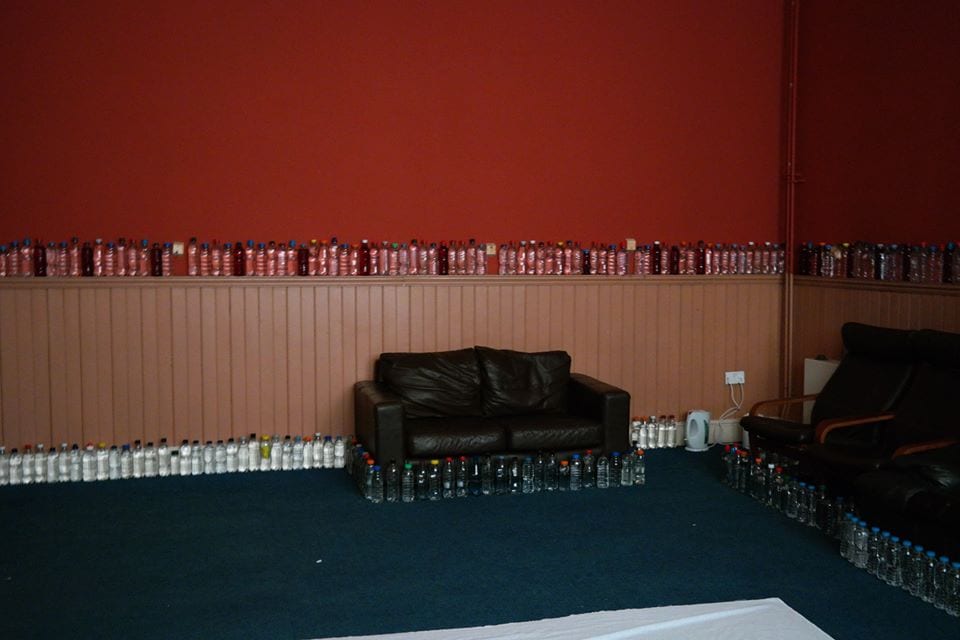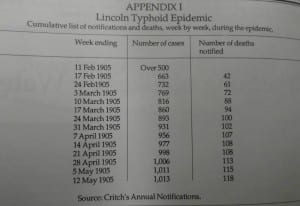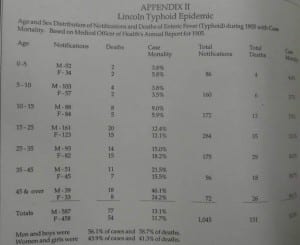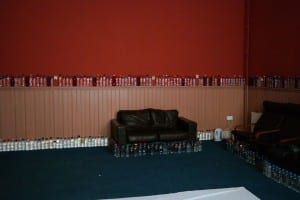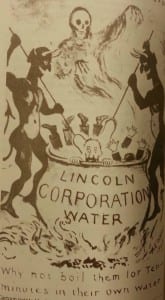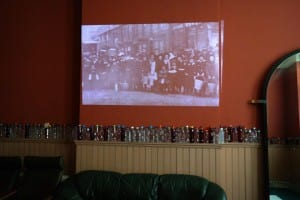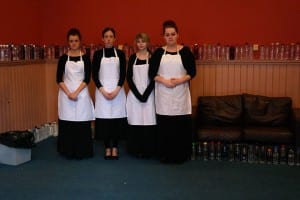‘Listen to me while I tell you of the famous Lincoln water’ – The song of Elkesley Water: After Longfellow by F. W. Thomas.
Framing Statement
The Final Countdown marks the 110 year anniversary of the typhoid epidemic that hit Lincoln in 1905. It is a combination of interactive performance and an instillation. The final performance took place on the 8th of May 2015, four days before the 110 year mark of the last recorded case of typhoid in Lincoln. The Final Countdown was inspired, created and performed at the Lincoln Drill Hall, which in 1905 was converted into a hospital to accommodate the victims of the typhoid. ‘People had a real familiarity with the space that was being worked with yet they were invited to experience the environment from a new perspective due to the performance that was enacted within it’ (Govan et al, 2007, p.120), the public recognize the Drill Hall as a place for theatre, but it’s vital role within the history of Lincoln is often overlooked or unknown, our performance hoped to shed light to the public of the history hidden in the walls of the Drill Hall, and to enrich their appreciation of the building, as without it the survival rate of the typhoid in Lincoln may have been much higher.
The Final Countdown focuses on the typhoid epidemic, leading to a focal word of water, which became a prominent part of our site-specific performance. The instillation created by bottles of water was a representation of the number of people that contracted typhoid and the number of people that died from the disease in Lincoln, becoming a memorialisation of those that died and the forgotten past of Lincoln Drill Hall. The interactive part of our performance focuses on creating an atmospheric experience for the participants. The reading of people’s personal accounts of the epidemic and the celebratory song that marked the end of typhoid and the access of clean water in Lincoln is to not only to educate but to create an emotional response, and then the experiencing of typhoid symptoms is to create an sensory experience.
As well as an instillation The Final Countdown is an interactive experience that requires audience participation. Each performance was capped at a three audience experience to create an imitate feel, mimicking the atmosphere of the Drill Hall when it acted as a hospital. Taking inspiration from You Me Bum Bum Train (2004) our participants became patients rather than audience members, to submerse them into the performance. The Final Countdown relies on the audiences willingness to participate, as the ‘patients’ were instructed to close their eyes to gain the full effect of the performance. ‘Interacting with a ‘real’ performance rather than witnessing an artistic event from outside the safety of the ‘fourth wall’ brings a different quality to the encounter with the artwork that may cause audience members to feel vulnerable.’ (Govan et al, 2007, p.28) The feeling of vulnerability is vital to experiencing the full effect of the performance, which is created by the closing of the eyes by the participants, placing their trust in the performers.
The duration of The Final Countdown is fifteen minutes; which each performance is a three person experience, each person experiences one of the three weeks of the typhoid symptoms with all experiencing the fourth and final week. Although all the weeks of symptoms are heard by all participants the experience of the patient changes depending on which week of symptoms they suffer with.
Analysis of Process
When first visiting the Drill Hall I noticed the contrast between the original entrance and the new entrance to the building. The Contrasts between the two entrances got me thinking about how this reflects the interior of the building. The main hall for example, which is now primarily used as a theatre, still has many features from the original structure, such as the iron beams on the walls and the balcony. These features which are sadly not on display like they should be are much like the Original entrance, which is now used as a back door, and most likely unnoticed by most visitors.
One of the first tasks we were given at the Drill Hall was to find the unnoticed spaces, and fill it with our bodies. Thinking back to my first thoughts on the Drill Hall, and the unnoticed architecture of the building, it got me thinking about the history of the building and how the Drill Hall has molded to the needs of the time. Some of the Drill Hall’s uses are not displayed on the walls for the public to see, but hidden within them, becoming unnoticed history.
When thinking of the Drill Hall its current use as a place of entertainment and its use during the world wars come to mind, but its use as a hospital during the typhoid epidemic is unknown to most people. ‘It is possible to be in a place without realizing its significance for the groups of people who have historically inhabited it’ (Pearson, 2010, p.24) for this reason I was intrigued by the Drill Hall’s past of being a hospital, and wanted to bring this forgotten history back into light, and remember those that lost their lives in the building because of the disease.
My group had done some research into the Drill Hall as a hospital during the typhoid epidemic. The researches lead us to find the dates of the epidemic, the number of those infected (1045), and the number of those that died (131). We also did research into the disease itself and discovered it was contracted by drinking contaminated water and what the symptoms of each week was, with the forth week usually being when the patient died.
Our original idea consisted of performing in the main auditorium, which is where the hospital beds where laid. Taking inspiration from Stan’s Café Of all the People in the World (2003) where they represented statistic, for example the number of people that die each day, with grains of rice, each grain being representation of a single person, we wanted to create an instillation from identification tags, each with the names of those that contracted the disease and those that died. The idea of using projection also interested us, providing the audience with visuals of the hospital and life during the six months that the epidemic lasted. Playing with the senses we had the idea of boiling water, which was recommended for people to do before drinking water during the Typhoid epidemic, and adding in disinfectant to create the smell of hospitals, and particularity the smell that would of been prominent in the Drill Hall during this time, as most bedding was soaked with disinfectant and most probably still damped when a new patient was brought in.
The trip to the archives on the 13th February 2015 became a turning point for our performance. Before the trip we decided on some research areas, which were the names of the people that died and what identification they used for the patients. Although we did find some of the names, we could not find many, or how they were identified. We did find some accounts from people that lived in and/or had a relative that contracted typhoid, this along with many photographs depicting Lincoln in this time, gave us a better understanding of the conditions people were living in and were being treated in. This then provided us with an idea of the type of atmosphere we wanted to create in our performance.
(Lincoln Archives, 2015)
The research at the archives really helped us shape our performance, as ‘a large part of the work has to do with researching a place’ (Pavis as quoted in pearson, 2010, p.7), after building on our knowledge we could assess what we wanted our audience to experience, and what effect experience this would have. Due to the lack of names we could find, but the first person accounts of the epidemic and the The song of Elkesley Water, which is about the first time Lincoln has clean water running through the pipes again. We decided to change our focus from the names to water, as water is what carried the disease.
Changing to the focal point of water lead us to alter the instillation, still sticking with inspiration from Stan’s Café of all the People in the World, we choose to represent the people who contracted typhoid in bottles of water, adding red food dye to some to represent those that died. Bottles of water is a better representation, than the identification tags, as we cannot be sure of what the identification method was, and on research it seem as though the identity of the patients was not overly important because of the vase number of people that gain the disease. Bottles of water show the quantity of people more clearly, and it celebrates our easy access to clean water, something which we may take for granted, but would have saved lives during the epidemic.
As we decided on bottles of water, we had to collect 1045, one for each person that contracted the diseases. We achieved this by putting out an appeal to our fellow students to save any clear bottles they has/used, buying as many as we could and we also asked the Library to keep any bottles they got, which they did. We then sat and sorted through the bags we received from the Library, to get the bottles that we needed.
In our original idea we wanted to perform in the main auditorium, as this is the known to be used as the hospital, but due to problems with the amount of space available, as two other groups also wanted to perform here, we changed our location. Inspired by our theme of water we decided that performing in the bathroom would be a great location to take advantage of the use of water noises, i.e. running water, water dripping and the flushing of the toilet.
We were given the task to research a practitioner and one of their performances that we could draw inspiration from. My group choose to research Marina Abramovic’s and Ulay’s performance Imponderabilia (1977). During this performance they stood naked in a door way facing each other, forcing their audience to enter between them. This placed their audience in an intimate but uncomfortable position. This performance influenced our performance at the Drill Hall, as during the typhoid epidemic people were kept in close and intimate spaces that would have created a sense of discomfort. As our performance is taking place in the toilets we felt a good way to recreate the sense of intimate but uncomfortable is to have our audience each seated in a cubical, which we would then each proceed to join them in, treating them like the patients experiencing the symptoms of typhoid. This creates the intimate but uncomfortable atmosphere as a toilet cubical is usually something we enter alone, but knowing someone is in there with you is uncomforting and their personal space is being invaded which adds to this atmosphere and also making it intimate by have two people in a small closed off area.
(Lincoln Archives, 2015)
As we did not want the instillation to be in the bathroom as well due to limited space in there, we went to find another room we could use. We were particularly drawn to the green room because of the atmosphere. The stain glass windows provided the feel of a church, which we thought was appropriate for an instillation that memorializes people.
I did some research in site-specific performances that took place in hospitals and stumbled upon one event that took place at the closing and relocating of Coventry and Warwickshire Hospital. The event was called One Last Look, it consisted of a performance and an exhibition called Sites of Memory (2006). The exhibition displayed objects from the hospital alongside memories of former staff and patients, ‘Utilising the empty space of the hospital, and filling it with these traces of the past’ (Online) This project inspired me when we were exploring what could be done in the green room, and the placement of the instillation. We discovered a space on top of the dado rail that ran around the room which we found we could fit the bottles of water on, therefore ‘Utilising the empty space (…) and filling it with these traces of the past’. In the event One Last Look memories are a significant part, which inspired us to read memories found in the archives about the typhoid epidemic in Lincoln. It adds the emphasis that it is important to memorialize these events. Memorializing is important to our performance as our process and performance is happening exactly 110 years since the outbreak.
We also wanted to have a projection of an image we found of children lining up, with buckets to go collect clean water. Originally we wanted the projection to be shown on the ceiling so when the audience lay down, they would see the image. We then decided we wanted the image to be seen as soon as the audience entered the room, as it would ensure they see it, we then wanted it to projected on the bottles of water, but as it was difficult to build a wall with the bottles for the projection to go. We notices a bit of wall the stood out from the rest, that we could project on. As the wall stood out it would draw attention to the image as soon as the audience entered the room. The reason for having the projection was because the green room was about visuals and memories, so it helped create the sense on the conditions of the time. The experiences in the green room where to help stimulate the imagination of our audience for when it can to being transferred into the toilets were they would become our patients.
We wanted to find a reason for them to be transformed into patients; we had the idea of making them drink water, so they would become ‘infected’ with the disease, dying the water red to give the impression the water was not safe to drink. When we first rehearsed this with an audience, we noticed people were hesitant to drink the red water as they were unsure as to what it was. This inspired us to perform as nurses, so we could easily relax and reassure our audience, so they would be more inclined to participate in areas of our performance such as drinking water and remaining with their eyes closed throughout the performance.
Performance Evaluation
Although our performance started when the audience members were being picked up, and taken to the green room, for me I felt like the performance started with the filling of 1045 bottles with water. If we were doing the performance again I would have liked to film this process as a pre-performance, as the filling of the bottles remained me of the photographs we saw of the children lining up with buckets of water going to collect clean water, as ‘site-specific performance can be especially powerful as vehicle for remembering and forming a community’ (Harvie as quoted in Pearson, 2010, p.9) I feel this process would of created a stronger atmosphere if the audience could of witness or taken part in this process.
Although we had a capped performance of three audience members at a time, we did not fill each performance; mostly having only two participants, but this did not cause too many problems, as we were able to carry on the performance as per usual. The audience responded well to our performance, especially with placing their trust in us to remain with their eyes closed throughout the performance, particularly when transporting them to a different location. Gaining the trust of the audience is a massive strength for our performance as the atmosphere we wanted to create to, was not only down to us to create it, but also down to the audience. One performance we noticed during the symptoms section, one audience member, while listening to what the patients would feel each week, was reacting to what was being said, for example holding their stomach when symptoms involving this area were being described. After this particular performance the participants gave us very positive feedback saying the performance was very atmospheric and they were intrigued to know more information.
After the first performance, which was experienced by Conan, he provided us with the feedback to remove the music from the video, as it was harder to hear what we were saying over the noise of the traffic outside and the music. We took this into consideration and for our next performance we performed it without the music. We found that the audience still remained relaxed and therefore still trusting, but they could focus more on what we were saying and took in the information better, so we continued to perform without the music. Another improvement I would make to the performance is to have more confidence with knowing our lines, as sometimes we would stumble on what we were saying, which brings the audience back into the awareness of the real world.
Originally I did not understand how we were meant to create site-specific performance in a building that is used for theatre, as my understanding of site-specific performance, was a piece of performance created somewhere other than a usual performance space. But throughout my journey of site-specific performance I discovered that a site is not what is there in the physical, it is what could be there, should be there and what has been there but is no longer there. So when you remove theatre from the Drill Hall you are still left with a site that is layered with exploration, be it unseen spaces, forgotten histories or overlooked objects.
Word count : 2,968
Works Cited
Govan, E. Nicholson, H. Normington, K. (2007) Making a Performance: Devising Histories and Contemporary Practice. Oxon : Routledge
Pearson, M. (2010) Site-Specific Performance. London : Palgrave Macmillan
University of Warwick, (2010) One Last Look: Sites of Memories Exhibition [Online] Avaliable from http://www2.warwick.ac.uk/fac/arts/history/chm/outreach/cwhp/events/onelastlook/sites
